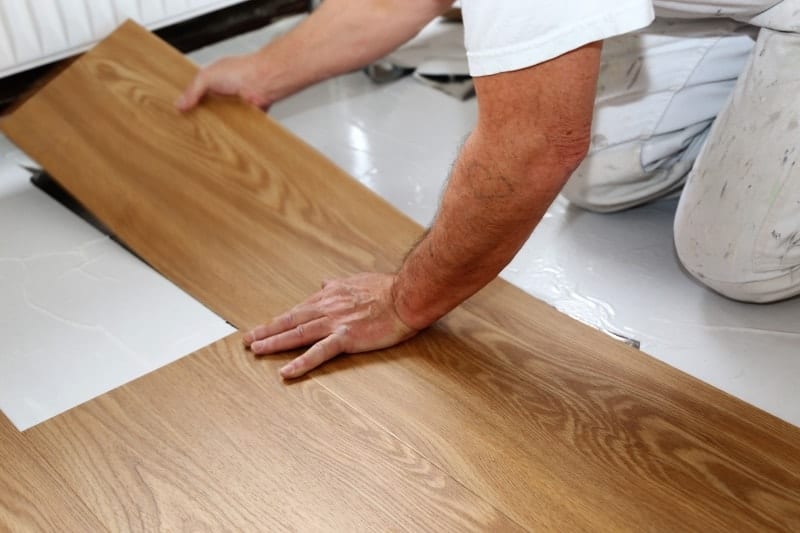parquet or tiles? When it comes to the floor covering in an apartment, the decision is often made between these two variants, depending on the room use.
Whether tiles or parquet is the better choice depends on subjective preferences, the spatial conditions and the respective material properties.
If you want to buy parquet, you should always keep the different variants in mind. Because here there are sometimes striking differences in quality.
Large price differences between parquet and tiles
There are sometimes considerable differences in prices, although the difference is of course always dependent on the quality. Tiles or parquet – that is not even the decisive point with regard to price differences. Instead, it is a decisive point for which parquet type you ultimately decide.
Parquet or tiles: Solid parquet costs between 40 and 200 euros per square meter
While you can get inexpensive multi-layer parquet in some cases for prices between ten and 15 euros per square metre, high-quality two- or three-layer parquet already costs around 30 to 50 euros per square metre.
The prices for real wood or solid parquet, on the other hand, start at around 40 euros per square metre. Depending on parquet type, wood species and parquet manufacturer the prices for solid parquet will increase. Thus, there are also variants in this area for which you have to invest up to 150 or even 200 Euro per square meter.
Tiles or parquet: prices for floor tiles vary between 25 and 80 euros per square meter
On the other hand, anyone interested in tiles will not be able to avoid porcelain stoneware with this designation.
These are ceramic tiles that offer extremely low water absorption.
As a rule, floor tiles are laid unglazed, although glazed and polished versions are also available from specialist dealers.
The respective prices vary depending on the quality. Thus, porcelain stoneware tiles with an appealing quality are already available from around 25 to 30 euros per square metre.
Especially high-quality floor tiles, which feature special surface designs and extraordinary designs, can also cost up to 80 euros per square meter.
Parquet or tiles: The cost-benefit ratio of parquet
However, the prices of tiles and parquet must always be considered in the context of the benefits.
Real wood or solid wood parquet has an extremely long service life. Because this type of parquet can be sanded several times, depending on the thickness of the lamellas.
However, this very good service life should not be underestimated in comparison to the cost of sanding down wear marks and the cost of new parquet sealing . As a rule, solid wood parquet is sanded every 15 years.
If you have installed multi-layer parquet instead, you can expect a comparatively limited service life of 15 to a maximum of 20 years. Depending on the thickness of the wear layer, multi-layer variants can often only be ground once, but at most twice .
Tiles or parquet: the cost-benefit ratio of floor tiles
If you choose high-quality tiles, you can expect a service life of around 60 years.
Tiles of this type usually have a high degree of hardness. The lower this hardness is, the more the shelf life shrinks.
In principle, however, tiles are always maintenance-free; there are therefore no renewal costs over the course of their service life no renewal costs.
With cheaper floor tiles, however, visible signs of wear are also produced, which is due to the lower degree of hardness.
Tiles or parquet – the essential comparison criteria
Even if, in addition to the price criterion, the subjective approach or one’s own perception is always important, there are important factors that can be objectively compared.
This gives you a valuable decision-making aid at any time for the question “parquet or tiles“:
1. Atmosphere and comfort
Basically, there are no two opinions here, whether parquet or tiles seem more comfortable and atmospheric. The parquet is clearly advantaged by the subtle structure, the comparatively soft surface and the flattering wood shades. Parquet creates comfort and atmosphere.
2. Naturalness and individuality
Parquet is manufactured industrially just like tiles. Nevertheless, wooden parquet is still a piece of nature. A natural look is given. Virtually every single parquet rod has an individual optical character. Tiles are available in many different colour variations and with different surfaces, but the naturalness and individuality of wood is missing here. Tiles often look sterile and underline a rather cool atmosphere.
3. Degree of hardness and resistance
Different types of wood are used for hardwood flooring. Some woods such as pine, larch, chestnut, spruce or alder are soft woods, while oak, robinia and scupira are hardwoods. Scratch marks are therefore also quickly visible on soft woods. It is enough if you have small stones in the apartment unintentionally stuck under your shoes and scratch them while walking over the hardwood flooring. Tiles, on the other hand, generally have a high degree of hardness and are therefore generally more hard-wearing and resistant than parquet.
4. Visibility of joints
When deciding whether parquet or tiles are the better choice, the subject of joints also plays an important role. For tiles, joints of about two to three millimetres are necessary. With parquet floors, joints are avoided for the time being by the laying technique or by the construction. In the winter months the picture changes and visible joints are formed between the individual laying units. This is due to the low air humidity in winter: the parquet or wood shrinks. Dirt often penetrates into these joints and is sometimes difficult to remove. A underfloor heating further intensifies this effect with parquet.
5. Color changes over time
Parquet flooring can change colour after a certain period of time – for example due to sunlight. Thus, over time, the parquet wood usually becomes darker, in some cases also lighter. Example light oak: the colouring becomes darker and darker over time and tends towards yellow. Tiles do not change their colour. The colour fastness is therefore maintained.
6. Cleaning and care
In order to preserve the optical speciality of parquet over a long period of time, the surface should be regularly treated with care oils and cleaning soaps or cleaned. tiles do not require such maintenance. Stains or dirt can be easily removed with a damp cloth.
But for this (oiled) parquet partially absorbs odours – a service that tiles unfortunately cannot offer 🙂
Tiles or parquet – the respective advantages at a glance
The benefits of parquet over tiles
- Parquet floors create comfort and atmosphere. In addition, parquet feels really warm right from the first skin contact, which makes underfloor heating virtually unnecessary. Tiles, on the other hand, are cold. They appear sterile and do not create any special cosiness.
- Parquet can be renovated several times, depending on the wood quality. This is not possible for tiles (only marble and granite can be reworked).
- The walking sound or impact sound is well insulated by the parquet just like the general room sound. This is especially the case if the parquet has been glued with parquet adhesive. Tiles tend to amplify the reverberation and also transmit sounds when walking more than parquet.
- oiled parquet can partially absorb odours. This applies both to kitchen odours and, for example, also to the smell of cigarette smoke.
The advantages of tiles over parquet
- Tiles have a greater degree of hardness. They are therefore more robust and less sensitive to scratches.
- Parquet flooring must be protected at heavily loaded areas with a floor protection mat.
- Tiles do not require any special care and are also easy to clean. Parquet, on the other hand, must be regularly machined with special cleaning agents.
- Even if tiles feel cold when in contact with the skin, they conduct heat much better than parquet. As a result, floor tiles are the best flooring for underfloor heating.
- wood works, stone and ceramic tiles do not. In winter, joints sometimes form between the individual rods or planks during the parquet. This does not happen with tiles.








